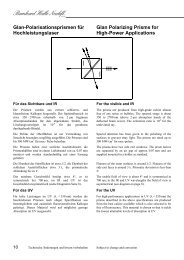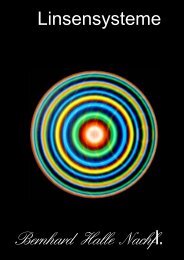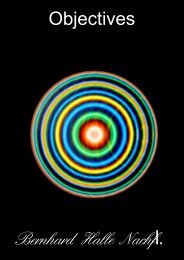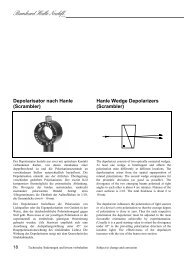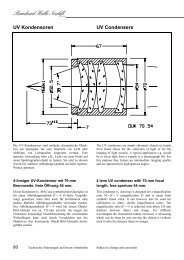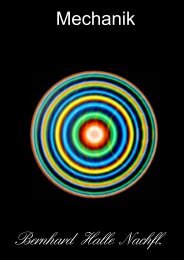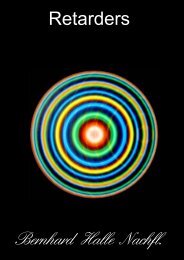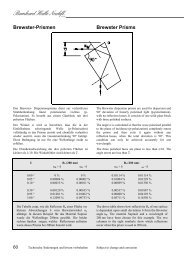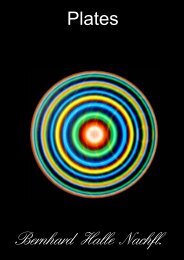Wollaston- und Rochon - Bernhard Halle
Wollaston- und Rochon - Bernhard Halle
Wollaston- und Rochon - Bernhard Halle
Sie wollen auch ein ePaper? Erhöhen Sie die Reichweite Ihrer Titel.
YUMPU macht aus Druck-PDFs automatisch weboptimierte ePaper, die Google liebt.
<strong>Bernhard</strong> <strong>Halle</strong> Nachfl.<br />
GmbH<br />
Glan-Polarisationsprismen für<br />
Hochleistungslaser<br />
Glan Polarizing Prisms for<br />
High-Power Applications<br />
Für das Sichtbare <strong>und</strong> IR For the visible and IR<br />
Die Prismen werden aus extrem schlieren- <strong>und</strong><br />
blasenfreiem Kalkspat hergestellt. Der Spektralbereich ist<br />
etwa 350 - 2700 nm (oberhalb von 2 µm beginnen<br />
Absorptionsbanden für den abgelenkten Strahl), das<br />
Löschungsvermögen ist 10 -6 für das geradeaus<br />
durchgehende Bündel.<br />
Die Politur der Oberflächen ist zur Vermeidung von<br />
Streulicht besonders sorgfältig ausgeführt. Die Prismen sind<br />
bis 300 MW/cm 2 für nsec- Pulse belastbar.<br />
Die Prismen haben zwei seitliche Austrittsfenster, die<br />
Prismenhälften sind in einem Luftabstand von ca. 0,07 mm<br />
montiert <strong>und</strong> werden standardmäßig mit einer Fassung<br />
geliefert.<br />
Die Ebenheit der Stirnflächen ist etwa λ/2, die Ebenheit der<br />
seitlichen Austrittsflächen etwa 3 λ, die prismatische<br />
Ablenkung bis zu 2'.<br />
Das nutzbare Gesichtsfeld beträgt etwa 8°, es ist<br />
symmetrisch bei 700 nm, im IR <strong>und</strong> UV ist das<br />
Gesichtsfeld unsymmetrisch (siehe Diagramm Seite 8).<br />
Für das UV For the UV<br />
Für hohe Leistungen im UV (λ < 350 nm) werden die<br />
beschriebenen Prismen nach obiger Spezifikation aus<br />
bestmöglichem <strong>und</strong> zusätzlich fluoreszenzfreiem Kalkspat<br />
gefertigt. Dieses Material wird auf möglichst geringe<br />
Absorption im UV ausgesucht.<br />
The prisms are produced from high-grade calcite almost<br />
free of any striae or bubbles. The spectral range is about<br />
350 to 2700 nm (above 2 µm absorption bands of the<br />
deflected beam occur). The extinction ratio is 10 -6 for the<br />
<strong>und</strong>eviated ray.<br />
Special attention has been given to the polishing of the<br />
surfaces to prevent stray light. The prisms are rated up to<br />
300 MW/cm 2 for nsec-pulses.<br />
The prisms have two side exit windows. The prism halves<br />
are separated by an air gap of approx. 0.07 mm and are<br />
supplied mounted in a holder as standard.<br />
Flatness of the outer surfaces is aro<strong>und</strong> λ/2. Flatness of the<br />
side exit faces is aro<strong>und</strong> 3 λ. Prismatic deviation is less than<br />
2'.<br />
The usable field of view is about 8° and is symmetrical at<br />
700 nm; in the IR and UV wavelengths the field of view is<br />
asymmetrical (see diagram on page 8).<br />
For high-performance applications in UV (λ < 350 nm) the<br />
prisms described in the above specifications are produced<br />
from the best calcite available which is also selected to be<br />
free of fluorescence. This material is chosen so that it yields<br />
the lowest attainable levels of absorption in UV.<br />
10 Technische Änderungen <strong>und</strong> Irrtum vorbehalten Subject to change and correction



